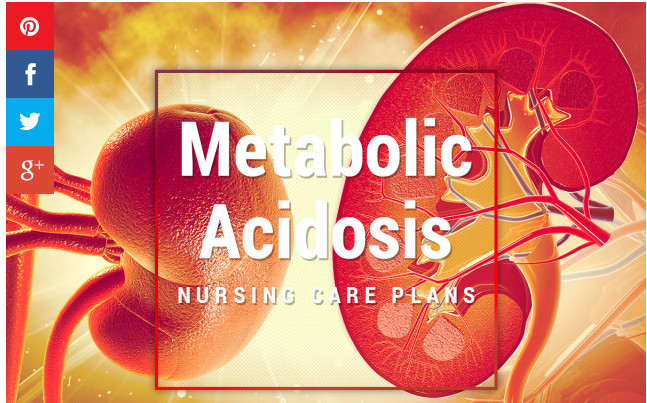Danh mục

Metabolic acidosis (primary base bicarbonate [HCO3] deficiency) reflects an excess of acid (hydrogen) and a deficit of base (bicarbonate) resulting from acid overproduction, loss of intestinal bicarbonate, inadequate conservation of bicarbonate, and excretion of acid, or anaerobic metabolism.
Here are general interventions for patients with metabolic acidosis.
Desired Outcomes
| Nursing Interventions | Rationale |
|---|---|
| Monitor BP. | Arteriolar dilation or decreased cardiac contractility and hypovolemia occur, resulting in systemic shock, evidenced by hypotension and tissue hypoxia. |
| Assess LOC and note progressive changes in neuromuscular status. Note neuromuscular strength, tone, movement. | Decreased mental function, confusion, seizures, weakness, flaccid paralysis can occur because of hypoxia, hyperkalemia, and decreased pH of CNS fluid. |
| Provide seizure or coma precautions and bed in low position, use of side rails, frequent observation. | Protects patient from injury resulting from decreased mentation and convulsions. |
| Monitor heart rate and rhythm. | Acidemia may be manifested by changes in ECG configuration and presence of brady dysrhythmias as well as increased ventricular irritability such as fibrillation (signs of hyperkalemia). Life-threatening cardiovascular collapse may also occur because of vasodilation and decreased cardiac contractility. Note: Hypokalemia can occur as acidosis is corrected, resulting in premature ventricular contractions (PVCs) and/or ventricular tachycardia. |
| Observe for altered respiratory excursion, rate, and depth. | Deep, rapid respirations (Kussmaul’s) may be noted as a compensatory mechanism to eliminate excess acid; however, as potassium shifts out of cell in an attempt to correct acidosis, respirations may become depressed. Transient respiratory depression may be the result of overcorrection of metabolic acidosis with sodium bicarbonate. |
| Assess skin temperature, color, capillary refill. | Evaluates circulatory status, tissue perfusion, effects of hypotension. |
| Auscultate bowel sounds, measure abdominal girth as indicated. | In the presence of coexisting hyperkalemia, GI distress (distension, diarrhea, and colic) may occur. |
| Monitor I&O closely and weigh daily. | Marked dehydration may be present because of vomiting, diarrhea. Therapy needs are based on underlying cause and fluid balance. |
| Test and monitor urine pH. | Kidneys attempt to compensate for acidosis by excreting excess hydrogen in the form of weak acids and ammonia. Maximum urine acidity is pH of 4.0. |
| Provide oral hygiene with sodium bicarbonate washes, lemon, glycerine swabs. | Neutralizes mouth acids and provides protective lubrication. |
| Assist with identification and treatment of underlying cause. | Treatment of disorder is directed at mild correction of acidosis until organ(s) function is improved. Addressing the primary condition (DKA, liver or renal failure, drug poisoning, sepsis) promotes correction of the acid-base disorder. |
| Monitor and graph serial ABGs. | Evaluates therapy needs and effectiveness. Blood bicarbonate and pH should slowly increase toward normal levels. |
| Monitor serum electrolytes, especially potassium. | As acidosis is corrected, serum potassium deficit may occur as potassium shifts back into the cells. |
| Replace fluids, as indicated depending on underlying etiology: D5W/saline solutions. | Choice of solution varies with cause of acidosis: DKA. Note: Lactate-containing solutions may be contraindicated in the presence of lactic acidosis. |
| Administer medications as indicated: | |
| Sodium bicarbonate or lactate or saline IV | Corrects bicarbonate deficit, but is used cautiously to correct severe acidosis (pH less than 7.2) because sodium bicarbonate can cause rebound metabolic alkalosis. |
| Potassium chloride | May be required as potassium re-enters the cell, causing a serum deficit. |
| Phosphate | May be administered to enhance acid excretion in presence of chronic acidosis with hypo phosphatemia. |
| Calcium | May be given to improve neuromuscular conduction and function. |
| Modify diet as indicated: low-protein, high-carbohydrate diet in presence of renal failure or American Diabetes Association (ADA) diet for the person with diabetes. | Restriction of protein may be necessary to decrease production of acid waste products, whereas addition of complex carbohydrates will correct acid production from the metabolism of fats. |
| Administer exchange resins and/or assist with dialysis as indicated. | May be desired to reduce acidosis by decreasing excess potassium and acid waste products if pH less than 7.1 and other therapies are ineffective or HF develops. |
Tin tức mới nhất
Sử dụng paracetamol dạng truyền tĩnh mạch (1 gram/100 mL)
DỰ THẢO VĂN KIỆN ĐẠI HỘI ĐẠI BIỂU KHÓA III, NHIỆM KỲ 2024 -2029

Wordwall là một công cụ dạy học trực tuyến
2 Diagnostics infirmiers NANDA 2021 -2023

Kỷ yếu hội nghị Điều dưỡng Bệnh viện HN Việt Đức 2022
Sample size calculator

Nghiên cứu bắt đầu từ đâu
Học thống kê với Dr Nuc

Hồi quy và tương quan
học Spss

địa chỉ open journal

Phần mềm điện thoại nursing